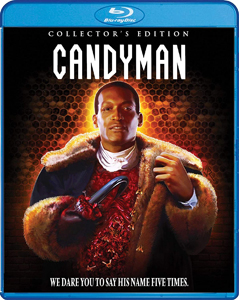“Candyman” (1992) has one of the most aggressively effective scores I’ve heard. Philip Glass’ organ-driven theme evokes beautiful churches (even though there’s no church in the film) to counteract the slimy Chicago slums. It hints at hope, then suggests despair. It’s oddly soothing.
What would the film – based on a short story by producer Clive Barker (“Hellraiser”) – be like without this score? It would be more mundane. Glass elevates “Candyman” to a unique horror classic.
Urban horror
That’s not to say there isn’t other good work done. Writer-director Bernard Rose and cinematographer Anthony B. Richmond capture the urban sprawl of Chicago, starting with a grand overhead panning shot under the credits.

From Aug. 25-27, we’re looking back at the first three “Candyman” films, leading up to the release of the fourth entry.

“Candyman” (1992)
Director: Bernard Rose
Writers: Bernard Rose (screenplay), Clive Barker (short story “The Forbidden”)
Stars: Virginia Madsen, Tony Todd, Xander Berkeley
Later, the projects apartment where Candyman (Tony Todd, with an evocatively enhanced voice) hides is a helluva setting. It’s a mix of nice livable units with others that have gone to ruin.
Helen (Virginia Madsen, “Sideways”) – writing her dissertation on urban legends – crawls from the bathroom cabinet of one unit into another, where a gruesome murder had taken place. Apparently the victim had summoned Candyman by saying his name five times into a mirror.
The closed-off apartment is creepy and gross enough to earn a “nope” from Helen’s friend and co-dissertation writer Bernie (Kasi Lemmons), and she is speaking for most viewers.
“Candyman” is religious horror without being about a religion, and a race-based story without being overt. Candyman speaks about his “congregation.” He wants to continue a cycle of death that began with his murder (when he was human).
It seems each of his murders – accomplished with his hook hand gutting the victim – enhances his immortality. Figuratively, of course, but also literally.
Hopeless Helen
This all plays in the background of Rose’s screenplay. The A-plot finds Helen framed by Candyman. It leaves a viewer feeling so hopeless for Helen’s sake that Candyman’s offer of being his next victim (and thus gaining “immortality”) becomes appealing.
While the “framed for murders” yarn is standard, it includes striking scenes, notably when Helen has to strip off her bloody clothes for the police – all of whom openly assume her to be guilty.
The wider “Candyman” mythology – such as “If he is killed for good here, how can he reappear in the sequels?” – mildly intrigues me.
I’m at the same place I was after watching the first “Hellraiser”: This isn’t totally my thing, but I appreciate the artistry. In that case it was driven by the practical special effects, here it’s Glass’ score.


